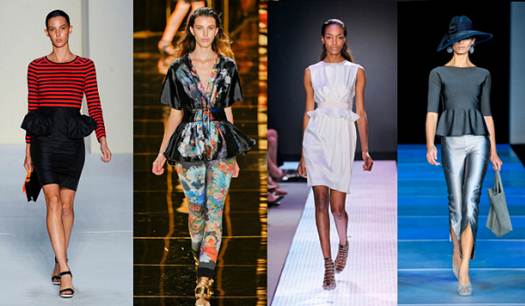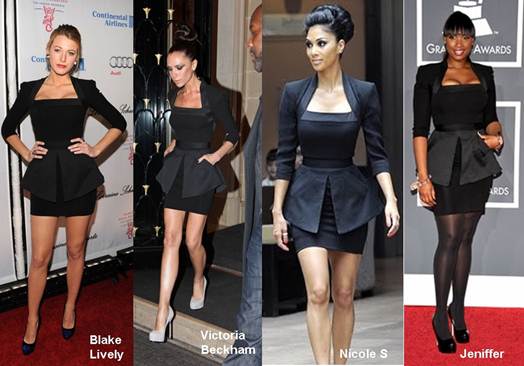Yes. And you can look good in one.
Learn how to love this season’s big hit with advice from designers, stylists.
Peplum. It isn’t an easy word. As a trend,
it’s even harder. In fact, this unnecessary, entirely redundant bit of fabric
sewn to the waist of an otherwise ordinary dress or top is up there with neon
and the bralette this spring/ summer as a one-season wonder. Except… it isn’t.
In case you missed the memo, peplums are more than just a thing at the moment –
they are the only thing. They have been for the past two seasons and are still
around for the next, flapping away on the catwalk and high street alike. But
why?

‘E peplum tricks the eye’, says designer
Roland Mouret, who knows pretty much everything about flattering the female
figure and has produced memorable peplum my numbers, including his follow-up to
the Galaxy, the Titanium dress, much-loved by celebrities. ‘It is a modern way
for a woman to disguise a part of the body that she might not love. For someone
who doesn’t have a lot of hip, it gives you a bit more of that attitude and for
someone who’s got a little stomach, it hides the situation’.
Still. I’m not buying it. I feel the same
way about peplums as I do about Kate Middleton and nude tights: I can see why
it happens but I don’t want to go there. Having said that, our Future Queen has
worn a peplum – albeit a teeny-tiny one on an otherwise conservative grey
jacket – and she’s not known for being fashion forward. Actually, it needs to
be noted here that the Royals do love a peplum: there are pictures of Wallis
Simpson in the 1940s and Princess Diana in the 1980s, both happily working the
trend. So what excuse for the rest of us?
‘There’s something very elegant and classic
in the proportions it defines’, reasons Mary Katrantzou, whose ‘lampshade’
dresses have helped establish the current idea of a dramatically structured
silhouette. ‘The peplum has an almost haute-couture appeal’. Design duo Peter
Pilotto agree, talking enthusiastically about the famous 1947 ‘New Look’ of
Christian Dior – ‘very fitted on the waist and sticking out on the hips’ – and
how they’ve reworked the idea in their own dresses, constructing peplums with
an integrated corset structure to help slim the waist. ‘It is’, they add, ‘such
an exciting shape!’ New Dior designer Raf Simons also agrees: he’s been
exploring the idea since September 2010, when his critically-acclaimed ‘ball skirts
and T-shirts’ collection for Jil Sander gave serious consideration to the
peplum.
The last time peplums were this popular was
the 1980s, when they were accompanied by bug shoulders. Nobody is reviving that
look. We did the big shoulder back when Christophe Decarmin was at Balmain and
got over it. Nor are they really about the waist (yes, we’ve recently been
through that, too), though it’s worth nothing that Marks & Spencer is
currently selling one of its new Waist Sculpt ‘soft wear’ corsetry pieces every
three minutes. Instead, the new peplums owe a debt to Kim Kardashian, surely an
unlikely style icon but one whose big bum, as us Brits would affectionately
call it, has proved surprisingly influential. ‘It’s all about this Bootylicious
thing that’s going on in culture right now’, confirms stylist Sophie Neophitou,
who works with everyone from Antonio Berardi to Victoria’s Secret and admits to
owning several peplums, including one on a black velvet top by Stella McCartney
from a/w 2011 that helped kick start the trend. ‘Men adore this idea of the
hourglass figure and a peplum can give you that. I’m quite curvy but actually
I’d say if you get the right one, they can be very flattering and hide a
multitude of sins. You have to be careful, though’, she cautions. ‘It’s not
just about getting any frilly peplum and wearing it!’

Ah, this is the thing. Do you want to know
I’m not convinced be the peplum? Because there are so many caveats to wear one
well. Basically, proceed with caution if you have a bosom or don’t have a
waist, if you have a body that’s short or hips that are voluptuous or legs that
aren’t giraffe-like. In fact, to be in the safe side, beware if you are in any
way lacking a thick ruffle around what is potentially your widest part seems a
dubious way to diminish it.
‘It’s like alcohol’, explains Mouret.
‘Everything in moderation’. So how to do the peplum properly? ‘They can’t be
too big and puffy’, emphasizes designer Justin Thornton of Preen, whose current
spring/ summer collection has beautiful crepe, lace and sequin pencil skirts
with a soft, flattering frill at the waistband that only require a simple
T-shirt or blouse to work. ‘They need to have just the right amount of gather’,
he adds, ‘and they need to be short’. Preen also produces jackets with a
ruffled waist that nod to the idea of a peplum while being easy to wear with
cigarette pants for a sleeker look. This is how Samantha Cameron did it at the
White House – albeit with a belted Roksanda Ilincic top – and if you can work a
peplum while meeting Michelle Obama, you’ve probably clinched it.
As SamCam proves, the top is probably the
most straightforward way to approach this trend – the high street has embraced
the idea with a great deal of enthusiasm and some skill, though choice of
fabric is key here. Try to avoid stiff, unforgiving ruffles – what you want is
a fluid frill. ‘When the fabric is crap, the peplum doesn’t sit properly’, says
Mouret, who also advises against overly dramatic looks for day.
As a statement piece, the peplum lends
itself well to red-carpet and evening dressing – but on a dress, the potential
for disaster is Kardashian-sized. ‘Keep the top part simple and waisted so the
focus is on the silhouette it creates’, advises Mary Katrantzou. In other
words, if your dress has a peplum on it, that’s probably the only sartorial
flourish you need.
I’m not going to tell you to embrace the
peplum this season. I’m finding it quite hard myself. Having said that, it’s a
trend that’s impossible to ignore – and one that can be done across so many
price points and pieces of clothing that there is inevitably a peplum that will
work for you, whatever your budget or body shape. ‘They can make you feel very
glamorous indeed’, says Sophia Neophitou, encouragingly. ‘It’s just a case of
finding the right one’.